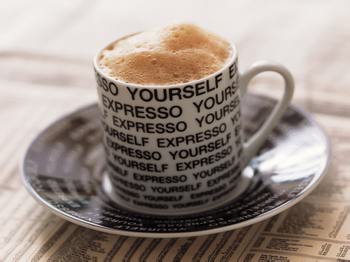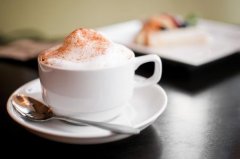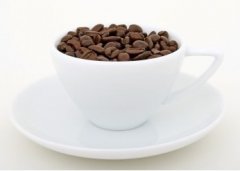Savor the coffee culture of European cafes

On Montsio Street in Barcelona, I found an European cafe called four Cats. Tourists kept stopping at the door to look at the small face of the European cafe and the poster by Ramon Casas. A middle-aged woman was responsible for guiding the tourists to their seats one by one, giving a very brief introduction to the history of the European cafe.
Many tourists come for Picasso. In 1899, 17-year-old Picasso held his first exhibition in this European cafe, and his paintings were used as the cover of the menu. In fact, the European caf é is closer to Ramon Casas, a well-off painter who studied painting in Paris in his early years and returned to Barcelona to build his own party place like the Paris Black Cat (Le Chat Noir). His business partner is Pere Romeu, who used to work as a waiter at Black Cat and is bent on setting up a good pub with moderately priced dishes and good music. In Spanish, "four cats" means three or five people. There have been architects Gaudi, musician Isaac Albenis, and so on. But it may be difficult for three or five friends to maintain a pub. Six years later, "four cats" also closed. Now the shop reopened in 1978, and admiring tourists are here to have a drink and have a rest.
In Spanish, there are three main types of coffee: cafe solo is black coffee, cafe cortado is with a little milk, and cafe conleche is with a lot of milk (Italian latte means milk). This is the origin of the so-called "latte". However, it was not an Italian or a Spaniard who invented milk and coffee, but a Viennese named Jerzy Franciszek Kulczycki, who was a war hero in the war against the Turkish Empire in 1683, and the city council rewarded him with money and a house, as well as a large amount of coffee seized from the Turkish army, so he naturally opened an European cafe after the war. The English name means "Blue bottle Cafe". He dressed in Turkish national costume to serve customers and mixed milk with coffee. He must have boasted to customers that although we had learned to drink this black thing from the Turks, the Turks had no idea that it could be mixed with milk. The Blue bottle, which opened in 1686, must be one of the earliest cafes in Europe. The cafe closed after his death in 1694, but he is still regarded as a hero by Viennese. Every October, there is a Kurkisky festival, and Viennese cafe owners paste his portrait on the window. There is now a street in Vienna named Kurkisky, and there is a statue of him on the corner.
There are said to be more than 600 cafes in Vienna, several of which are famous, such as Sacher Cafe, Sperl Caf é, Hawelka, etc., but tourists prefer to visit the "Caf é Central", which has the most stories.
Walking into the coffee center, there is a statue of Adenberg, sitting in a chair with his hand on the coffee table. The writer writes in this European cafe, meets Schnitzler, is appreciated, and walks into the literary world. Today, people are not familiar with his works, but most of them know a slogan: "I am not at home, in the coffee shop; not in the coffee shop, on the way to the coffee shop." This sentence was originally used to talk about the relationship between Adenberg and the Coffee Center, but it gradually evolved into Adenberg's master. If there are some literary cafes in the world that are willing to build a small blackboard at the door and write a famous literary quote, then Adenberg can be called the initiator. He once wrote a poem like this: "if you are depressed, no matter what, go to a cafe!" Your income is only 400 kroner, but you are willing to spend 500 dollars to go to a coffee shop! You hate the people around you and despise the people around you, but you can't do without them. Go to the cafe! "
As for "people who despise the left and right, we can't do without them," wrote Alfred Polgar, another regular visitor to the Coffee Center. "most people in the cafe dislike the world as much as their desire for it. They want to be alone, but they need company." Nowadays, many tables in the Coffee Center have a table sign indicating which celebrities have sat here, and you have a famous person to accompany you with a cup of coffee.
The drink list of "Coffee Center" is a little complicated. In addition to mocha, cappuccino and Espresso, there is Melange, which is half coffee and half stirred hot milk, Kaiser Melange is coffee with whipped cream and an egg yolk, Mazagran is iced coffee with ice and black cherry wine, Kaffee Amadeus is obviously related to Mozart, coffee with cream and Mozart. I chose a cup of Coffee Center Coffee, the shop's signature coffee, with almond and cream. There is a famous coffee saying: "only Irish coffee can provide four food elements-caffeine, alcohol, fat and sugar-in a small cup." I also have these four things in my signature cup of coffee. In the morning, the "coffee center" is 80% full, but there are still newspaper shelves in the shop, offering all kinds of newspapers to read. Many people have come to have breakfast, a piece of bread and a cup of coffee, which is the same meaning as when we eat soy milk Youtiao in the morning. In essence, coffee is also a kind of soybean milk. Coffee is originally a kind of berry. After removing the pulp, coffee beans are left, ground into powder, and then made into "coffee soybean milk" by various means. When traveling, we will visit a famous cafe and imagine the literati gathering here, but when we drink coffee, we will pay attention to whether the coffee oil is orange and whether the milk foam is delicate or not. will pay attention to the balance between bitterness and sour taste and mellow thickness.
From Vienna to Zurich, it is natural to have a look at the famous Odeon Cafe. The European cafe is on the edge of Lake Zurich, where Lenin used to play chess when he was in exile in Switzerland. He didn't like the cosy citizens of Switzerland. Other famous guests here are Albert Einstein and James Joyce in exile in Switzerland. A guidebook says that Dadaism originated in this European cafe. In fact, art youths who escaped the war in Zurich during World War I are more likely to meet in the nearby Voltaire pub. After having a drink at Odeon Cafe, which is preparing to celebrate its 100th anniversary, I plan to walk to Voltaire and see a haunted Starbucks within 20 meters. According to the European view, Starbucks offers mediocre coffee, and the taste of capital is stronger than coffee, but can European cafes provide better coffee? In terms of the prices of the "four cats", "coffee center" and Odeon coffee, they are all higher than the average price of European cafes. This added value is the so-called "cultural significance" of coffee. It costs an extra one or two euros to drink a cup of coffee in places where Picasso, Zweig and Einstein have had coffee. What do we want to drink from a cup of coffee?
Important Notice :
前街咖啡 FrontStreet Coffee has moved to new addredd:
FrontStreet Coffee Address: 315,Donghua East Road,GuangZhou
Tel:020 38364473
- Prev

The Coffee Culture in Central and Northern Europe
The coffee culture in central and northern Europe is neither as passionate as the Italian nor as romantic as the French. People in central and northern Europe drink coffee rationally and gently, just like its organized nationality. European life and coffee culture have become almost inextricably linked. In addition to the distinctive coffee culture in Italy and France, Austria, Switzerland and Germany
- Next

A detailed discussion on the General knowledge of Fine Coffee Culture in Hungary
Hungary is not only a unique hot spring kingdom, but also a veritable coffee empire. Budapest was known as the city of 500 cafes at the end of the 19th century. Cafes are the gathering place of Hungarian literati. Many writers go to fixed cafes and sit in fixed seats every day, and many of their works are done in cafes. Most of the addresses on these writers' business cards
Related
- How did the Salvadoran coffee industry develop in Central America?
- What exactly does the golden cup extraction of coffee mean?
- The Origin of Coffee flower
- [2023 Starbucks World Earth Day] there are more meaningful things besides free Starbucks coffee!
- What kind of coffee is there in Spain? 9 Flavors of Spanish Coffee
- Aromatic African coffee| Kenya's coffee culture and historical production area
- Liberica Coffee Bean knowledge: the characteristics of Liberian Coffee beans of the three original species of Coffee beans
- The origin and formula of Spanish latte introduces the taste characteristics of Bombon coffee in Valencia, Spain.
- How to adjust the solution of over-extracted coffee
- What is the tasting period of coffee beans? What is the period of coffee and beans? How should coffee wake up and raise beans?

